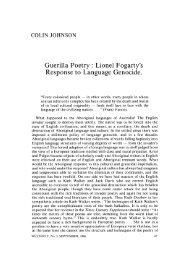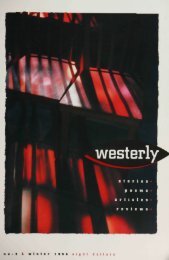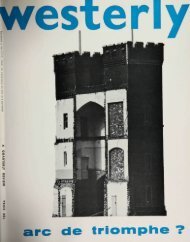Deficiency Bill in Western Australia, 1929,entitled 'Preventing the Unfit from Breeding.'This thorough and lucid expose, whilemaintaining the stance of detachment suggestedin the claim that 'this essay will examine thebackground to the introduction of this bill andthe reasons for its defeat in the legislature in 1929'is deadly in its coolly ironic condemnation of theattitudes uncovered. All the benightedarguments about Eugenics, compulsorysterilisation and segregation, are skilfully putinto perspective by quoting Arthur Lovekin,whose concern that the better classes were notbreeding enough and the lowest orders breedingtoo much was poetically stated thus: 'we are notperpetuating our species from the ripe fruitswhich is to be found in the uppermost parts ofthe tree, but from the weeds which grow apaceat the bottom.'It is good to see that the general mix of thebook is enriched by at least one essay drawingits material from imaginative literature. VeronicaBrady, in 'The Struggle against Forgetfulness'examines the theme of childhood in the novelsof Randolph Stow. 'The literary text,' she writes,'offers access to what is otherwise inaccessible,but vital, to the historian - the lost, potentdisorder of the forces of childhood experience. . . The language of the historian is thelanguage of alienation, precise, universal andtechnical: literature attempts to recharge thelanguage, to fill it anew with existential content.It does this by means of the symbol, the languageof experience.' She goes on to demonstrate howthe work of Randolph Stow is particularlyvaluable in this context, and provides a powerfulargument for the recognition of the enormousimportance of reading imaginative literature inharness with historical material to gain a deeperunderstanding of both.A better acquaintance with literary textsmight well repair some of the havoc wrought bythe professional jargon of some of the newerdisciplines. For example, Patricia Baines'material about Nyungar childhood experienceswhilst interesting, is marred by linguisticclumsiness in trying to force a blend ofaboriginal concepts and jargon as in 'Nyungarchildhood as remembered experience is, then,the invocation of ties, not to the past in a generalsense, but to those particular others who, fromthe space of intimacy, gave life meaning andshape. For the past as artefact of recollection isalways mediated through a series ofrelationships '.Both Phyllis Garrick's piece on Children ofthe Poor and Patricia Crawford's work on theLady Gowrie Centre display an odd lack ofperspective. Garrick's example of child abuse,complete with family attitudes to violence andincest (drawn from 1829-1880) are strikinglysimilar to our own contemporary experience, yetthere seems to be no awareness of this, and theyare treated as something peculiar to another age.Crawford, on the other hand, concentrating onthe conflicts and incongruities of attitudesbetween the staff at the Lady Gowrie centres andtheir largely working-class clientele does sothroughout with an accusatory undertone. Sheresolutely disregards the fact that communityattitudes half a century ago were so differentfrom our own era that a more appropriateresponse might have been that of ananthropologist dispassionately investigating analien culture. Seeing the conflict primarily as aproblem of class, i.e. working-class childrenstunted by a middle-class system seems toobscure the more basic concern of children beingstunted by adults.Such minor flaws do not detract from theenormous interest of all these essays, and thebook opens up new insights, charts somerelatively unknown territory and points to areasawaiting further research in a rich and rewardingfield.Margot LukeDorothy Johnson, Maralinga, My Love: ANovel, McPhee Gribble/Penguin Books, 1988,$12.99.In October 1957, a massive atomic test, the lastin a series, was undertaken by the BritishGovernment at Maralinga in South Australia.The following day the Canberra Times reportedthat a cloud of radioactive dust would travelseveral times around the world before dispersing.This and other press reports at the time seemedto be at pains to minimise public fear over thetests, describing damage no more serious thansome singed hairs on the legs of a servicemanstanding several miles away from the blast110WESTERLY, No.2, JUNE, 1989
(Canberra Times 10 October 1957, p.l). Formany years the Australian public was notinformed about the purposes or the effects of thetests and to this day the aim of some of themhas not been revealed.The secretive, confused world of the Britishatomic tests in Australia in the late 1950s is thesetting for Dorothy Johnston's new novel,Maraiinga, My Love. The book's prefatory notetells us that for the entire decade between 1953and 1963 the British tested weapons in remoteparts of Australia, exploding bombs rangingfrom one kiloton to twenty-five kilotons (thelargest being bigger than the Hiroshima bomb),above the ground in one of the driest, dustiestplaces on earth.Echoing the title of Alain Resnais' andMarguerite Duras' 1959 film, Hiroshima, MonAmour, Maraiinga, My Love is a curious novelwhich explores the problematic and destructiverelationships among men and women and theirpost-war world. (And it too might make anevocative and disturbing film.) On a firstreading, it seems a sparse, understated novel, aseries of somewhat disconnected scenes whichaccumulate to form an incomplete picture of theevents surrounding the biggest tests in 1956-7.The effect is at times slightly confusing for thereader as the narrative slips across charactersand events which never quite add up in Realistterms. But this is in fact a superbly effectivemethod of portraying the acute passivity andconfusion which seems to have afflictedAustralian society at this time. And the text'sapparent bareness and use of non sequitor reveala richness and complexity which are at onceaesthetically satisfying and politicallystimulating.The novel is centred around GrahamFalconer, a young Australian soldier sent towork on the test site, and explores his gradualdiscovery of the meanings of the tests for hiscountry and for himself. The tests had somedisastrous effects upon the land and itsinhabitants and these are revealed in the courseof the novel: the outback is penetrated by whitemen more quickly than it would otherwise havebeen and this leads to disease and destructionfor many aboriginal people and theirenvironment. In tum, many of the whites whoinvade the interior will die from cancer and otherradiation-linked diseases. Some, like Grahamand his boss, the scientist Charlie Hamilton, tryto contain the excesses of the tests and to clearWESTERLY, No.2, JUNE, 1989up afterwards only to realise that they have beenunwitting collaborators.Graham works at Maralinga in 1956-7 andmost of the narrative is located there, amongstthe men preparing the sites for the tests andmonitoring them afterwards. Other sections ofthe book deal with Graham's later education asa scientist, his journey to England and hiscomplex and diffident relationships with othermen, his wife, Deborah, and his family. Heuncovers shocking evidence of the secret use ofcobalt 60 and plutonium in the bombs, much ofwhich was simply left, contaminating the land;shrouded in secrecy by the British and Menzies'minions, whose refusal to admit the precisenature of the tests makes it necessary to denytheir dangerous effects as well.What is particularly striking in all of this isthe book's portrayal of the passive behaviour ofthe Australians involved. The men on the testsites, for example, leave their wives behind indrab 1950s suburbs to spend months with theirsecret mistress, the land, preparing it for a seriesof events which they don't understand and whichwill spectacularly destroy it. A strange love,indeed. And, in learning to stop worrying andlove the forces that oppress them, the men in thenovel achieve a masochistic kind of ecstasy.Graham realises, for example, that he can neverexplain 'what it meant to be standing besideCharlie Hamilton as the bomb went off, givinghimself up to something that was beautiful anddangerous beyond words, or any humanlikeness.' (p.63)Complex patterns of masculine desire tosubmit to authoratitive (father) figures -knowledgeable scientists, Menzies, England, thebomb itself - and to dominate or destroysymbols of the feminine - notably the land -are subtly and at times painfully explored as themel} gently blunder from a state of innocence toan understanding of what they have allowed tohappen to their country and to themselves.Those most affected by this struggle were, ofcourse, the aboriginal people in the outback, andthe novel tells of the secrecy, indifference andsheer incompetence which prevented theauthorities from taking adequate steps to protectthem from contamination. A scene in whichGraham and his co-workers attempt to decontaminatean aboriginal family (who cannotspeak English) is a masterpiece of the grimmestkind of farce (pp.j77-83).There is also a wonderfully dry, ironicIII
- Page 3 and 4:
CONTENTSWESTERLYVOLUME 34, No.2, JU
- Page 5:
WESTERLYa quarterly reviewISSN 0043
- Page 8 and 9:
JAN KEMPTo My Father, M.H.K.My fath
- Page 10 and 11:
JAN KEMPThe GypsySuddenly before yo
- Page 12 and 13:
WONG PHUI NAMA Death in the WardThe
- Page 14 and 15:
WONG PHUI NAMCousinI had to call to
- Page 16 and 17:
WONG PHUI NAMObitIt is as thin smok
- Page 18 and 19:
So thus I lie here fearful of movem
- Page 20 and 21:
VIRGINIA BERNARDA ValedictionWhen N
- Page 22 and 23:
"Yeah, yeah," I call, returning the
- Page 24 and 25:
she flops for a bit, slurps her tea
- Page 26 and 27:
well her students did, she was neve
- Page 28 and 29:
English or Indian, that they had th
- Page 30 and 31:
ANDREW TAYLORSpringSpring is a dive
- Page 32 and 33:
CAROL SElTZERAiming for the MouthTr
- Page 34 and 35:
GRAEME WILSONA Selection of Japanes
- Page 36 and 37:
a highly ambivalent attitude to his
- Page 38 and 39:
Esson attended some rehearsals of T
- Page 40 and 41:
the literary life of Bloomsbury. Lo
- Page 42 and 43:
Without Yeats Esson would quite lik
- Page 44 and 45:
"What theatre do you have in Austra
- Page 46 and 47:
In the back room Esson could feel t
- Page 48 and 49:
"When we started our little theatre
- Page 50 and 51:
a screen against a wall. A theatre
- Page 52 and 53:
VINCENT O'SULLIVANSinging Mastery:
- Page 54 and 55:
flighty relation in most statements
- Page 56 and 57:
living and the dead; that places hi
- Page 58 and 59:
quite diverse traditions towards th
- Page 60 and 61:
WARRICK WYNNEThe Wetlands (for Liam
- Page 62 and 63: JAN OWENSmileOur mother aimed the b
- Page 64 and 65: RICHARD KELLY TIPPINGOlympic Airway
- Page 66 and 67: DAVID REITERBear by the Jasper Road
- Page 68 and 69: (At twenty eight you did not bother
- Page 70 and 71: left, would have risen and walked o
- Page 72 and 73: He had hair like mine used to be, t
- Page 74 and 75: OLIVE PELLThe QuestionTell me how t
- Page 76 and 77: BRIAN MOONANAT 515: MASS LECTURE Th
- Page 78 and 79: PETER KIRKPATRICKTear HereThe bay i
- Page 80 and 81: JOHN WINTERThe Bird ManIn wooded, p
- Page 82 and 83: KNUTE SKINNERAugust 15There's a lig
- Page 84 and 85: M.E. PATTI WALKERThe Hook"Aren't yo
- Page 86 and 87: QMNQMNQMNQMNapartheid man, this is
- Page 88 and 89: QMNQMNQMNeasy because you don't bel
- Page 90 and 91: lands or which have been taken over
- Page 92 and 93: GEOFF GOODFELLOWToo MuchDianne is 1
- Page 94 and 95: SHANE McCAULEYSouth Fremantle, Summ
- Page 96 and 97: JEAN KENTWaiting Out the DroughtWai
- Page 98 and 99: STEPHEN MAGEEJesus Falls, South Aus
- Page 100 and 101: SIMON BROWNBlue Hole, Santothe colo
- Page 102 and 103: CONAL FITZPATRICKA Brown Dog, Off A
- Page 104 and 105: PAUL HETHERINGTONOne RoomIn teeming
- Page 106 and 107: society, or, in the terms of the my
- Page 108 and 109: emphasised (I think) in the referen
- Page 110 and 111: Summer Leaves". This continues the
- Page 114 and 115: invocation of pastoral near the beg
- Page 116 and 117: particularly dreaded). The final re
- Page 118 and 119: VINCENT O'SULLIVAN - is one of New







